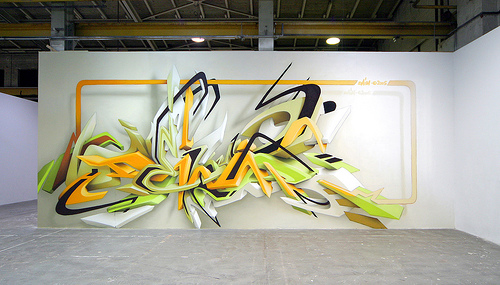
Whether you’re walking through a city neighborhood or strolling around the graffiti-sprayed walls of 798, there’s no doubt you’ve encountered the masterpieces of visual art that have manifested themselves in the public domain.Theartwork is made for no museum, but rather, for the bridges, billboards, and broken-down windows that often define urban landscapes today. Though often associated with rowdy teenagers who have access to spray paint, street art goes far beyond the juvenile delinquencies of drawing a smiley face on your neighbor’s garage; it acts as a form of personal, professional, and even political expression. Here are some types of street art you should be familiar with:
1. 3D Street Art
Out of all the forms of street art, 3D street art is probably the most visually impressive. Often hand-drawn on the pavement with just some chalk or paint, these large-scale optical illusions are frequently crafted with the purpose of creating mind-boggling landscapes right on the ground in front of you. Whether 3D art deceives you into thinking there’s a hundred-foot waterfall in front of your local bakery or a great white shark jumping out of the pavement, itremainsone of the most remarkable (and possibly frightening) forms of street art.
2. Street Installations
While conventional street art is often done on walls or on other flat surfaces, street installationsare oneform where the artist uses three-dimensional sculptures or objects placed in a public setting. Street installationscan range from simply gluing a traffic cone on a sidewalk to positioning octopus tentacles out of windows to simulate the second coming of the kraken. Not even joking.
3. Video Projections
Perhaps the most modern form of street art, video projection is one that has recently gained popularity among visual artists. The name says it all—in video projection, an image is shone from a projector onto a wall, building, or sculpture. Most recently, during the Occupy Wall Street movement in 2011, protestors projected “bat-signals” onto buildings around New YorkCity as a call for the “99%”.
4. Sticker Bombing
Sticker bombing is exactly what one might think it is—artists go around and place stickers almost anywhere. Sticker art is most popular among activists who often print out and paste thousands of stickers around cities to promote a certain political agenda. These “sticker bombers” even go as far as to print their messages on super-adhesive and super-durable material, making the messages almost impossible to remove. It’s literally a sticky situation.
5. Yarn Bombing
Similarly to sticker bombing, yarn bombing entails taking a public area or monument and wrapping it in colorful yarn. Though lacking in the underlying political messages spread by the aforementioned stickers, yarn bombing is often used to createmore colorful and welcoming environmentsin contrast to dull city surroundings. Someone even yarn-bombed the Wall Street bull in a beautifully crocheted coat of pink and purple fabric. Take that, investment bankers.
6. Graffiti
With roots tracing all the way back to Ancient Egypt, graffiti is probably the most common and diverse form of street art. Normally created with simple markers and spray paint, graffiti can be anything from just a couple words to an elaborate masterpiece of a mural. Graffiti can also act as a not-so-subtle personal advertising technique (especially in China.
7. Stencil Art
A variation of graffiti, stencil art allows for a more intricate creation of street art. The artist usually cuts out a portrait out of cardboard or paper, and then sprays or paints over it onto a flat surface to create the image. Likewise to the stickers, this technique allows for quick and easy image reproductions and is thus sometimes used for the same conveying of political ideologies.
8. Street Posters
Just as advertisements for a play or movie are pasted on surfaces all over cities, so are street posters. One of the more conventional forms of street art, these posters are commonly drawn or printed off and used to communicate a specific message to the public. These messages can be seriously political or possibly even humorous at times. It’s almost like contemporary propaganda, but illegal.
This article originally appeared in the Nov-December 2013 issue of UNIT-E. It was written by Alex Gong, a student at International School of Beijing.
About UNIT-E
UNIT-E was founded in the spring of 2010 with the aim of establishing a non-profit, student-run magazine for international students in Beijing. Staffed by current students from a range of international schools, the magazine provides an amalgam of cultural tidbits, fragments of Beijing student life, and a broad spectrum of unique perspectives from a diverse group of young adults.
Photo courtesy of CBS_Fan (Flickr)



